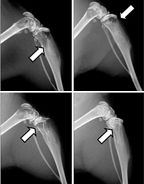Metastatic Breast Cancer Cells Diminish Body’s Immune Response
A new study suggests suppression of breast cancer metastasis relies on an antitumor immune response. Researchers found that administering interferon can reduce bone metastases and increase the survival time of a metastatic breast cancer mouse model.
Scientists in Australia have found that metastatic breast cancer cells suppress an immunologic pathway. Belinda S. Parker of the Peter MacCallum Cancer Centre in Melbourne and colleagues show that administering interferon (IFN) can reduce bone metastases and increase the survival time in a metastatic breast cancer mouse model.
The study suggests suppression of metastasis relies on an antitumor immune response. IFN treatment of the metastatic breast cancer mouse model resulted in lower immune suppressor cells and increased numbers of immune effector cells, mainly natural killer cells, in the bone marrow of these mice.

Representative x-ray images from the hind limbs of mice. Arrows indicate osteolytic lesions. Source: Dunn LK, et al.
PLoS ONE
4(9), 2009, e6896
The study, published this week in Nature Medicine, supports the notion that tumor surveillance by the immune system regulates metastasis but not primary tumor development. Clinical tumor sample analyses “support the mouse data that the IRF7 pathway is crucial for the suppression of bone metastases in human breast cancer,” state the authors.
The researchers also provide support that this mechanism is at work in human breast cancer. Analyses of samples from more than 800 breast cancer patients showed that those who had high levels of gene expression in this pathway also had a lower frequency of relapse to bone tissue.
By comparing the gene expression levels of primary and metastatic breast cancer cells from a mouse model the researchers identified a group of genes, regulated by the regulatory factor IRF7, highly expressed in primary but not metastatic cells. These IRF7-regulated genes are innate immune pathway IFN-regulated genes that are downregulated in breast cancer cells but not in immune cells. This suppression “restricts immunosurveillance to enable metastasis,” state the authors.
Adding back high IRF7 expression to the breast cancer tumor cells or treating the mice with type I IFN resulted in higher immune activity. Parker and colleagues posit that an immune response-specifically CD8-positive and natural killer cells-is needed to prevent metastasis. Depletion of both these cell types did not affect primary tumor growth, but sped up the time to metastasis and decreased survival time of the mice.
More than 80% of breast cancer patients die as the disease spreads, especially to bone tissue. However, how breast cancer spreads and why breast cancer cells specifically metastasize to the bone is not clear.
Validation Using Human Tumor Samples
Consistent with the mouse experiments, metastatic breast cancer tissue had lower IRF7 expression (only 3 of 18 samples) compared to either normal breast tissue or primary breast cancer samples (9 of 16 tumor samples expressed IRF7).
Of nine matched primary-metastatic tumor sample pairs, only one pair expressed IRF7 in both primary and metastatic tissue. In seven of these pairs, IRF7 was present in the primary sample but not in the metastatic tissue.
Using an expression database from 855 primary tumors where the first site of metastasis was known, low expression of the IRF7 gene cohort (or signature) was associated with a greater number of bone metastasis events. This ability to predict bone metastasis, according to the authors, was independent of other tumor factors such as estrogen-receptor status, tumor size, or lymph node involvement.
Zoledronic acid is currently being evaluated as a therapy to prevent bone metastasis in breast cancer patients in the adjuvant setting. Parker and colleagues suggest that the IRF7 gene expression signature may facilitate identification of those patients who are at high risk for bone metastasis.
New Questions Raised By Research
There are many open questions raised by the current study. “It is still not clear why this signature may be specific to bone metastases but not for primary tumor or other non-bone metastases,” said Yibin Kang, PhD, professor of molecular biology at Princeton University, who also studies the mechanism of breast cancer metastasis but was not involved in the current study.
There is spontaneous and continuous dissemination of cancer cells from the primary tumor, and these cells are likely to be heterogeneous. “Some cells land in the bone and the ones with lower IRF7 expression may survive better,” said Kang. “There is also the possibility that tumor cells interact with the bone microenvironment which facilitates suppression of these genes.”
Whether the immunologic pathway is suppressed in the bone microenvironment is not clear. “Knowing this is actually quite important to understand causes and consequences,” Kang said.
Newsletter
Stay up to date on recent advances in the multidisciplinary approach to cancer.